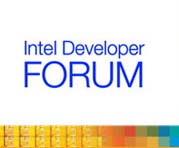Mobile Solutions

Computing devices are getting smaller and more powerful, and Intel's focus on mobile solutions is set to continue this. This was the topic covered by Sean Maloney in today's Keynote. Sean is a strong believer in the mobile connectivity solutions available to consumers and businesses.
Comparing the 'old' with the new, a 3 year old IBM Thinkpad was presented to the floor, along with the latest in mobile phone and PDA technology. A 3 year old Thinkpad remains a reasonable piece of mobile hardware, but a PDA with an Intel low power processor, capable of smoother video playback than the Thinkpad demonstrates the leaps companies such as Intel are making in mobile performance.
However, framerates are not everything. Features are beginning to take precedence over performance. Take battery life extension serving as an example. Although battery technology improvements allow for smaller cells and longer life, the devices using them much also be more efficient in their power consumption.
Flash storage technology is in the picture again too. Intel have moved back in to the flash market with a new focus. We're set to see Sibley which is their 90nm multi level cell flash, then we have Sixmile which is flash for other mobile platforms, and for multimedia applications there is Naubinway.
Last night HEXUS managed to have a very detailed chat with Pat Gelsinger who informed us of some new technology which Sean would show today. This included “button connect,” a technology aimed at making it easier to transfer data from mobile phones. Another usage model which Intel are working on is Internet access through mobile phones and laptops. Currently, accessing the net on your laptop, through a mobile phone, can be a cumbersome and unreliable experience.
To demonstrate high bandwidth wireless connections, Intel held a short video conference call between the IDF centre in San Francisco and a plane in the air above. The connection between the locations was 5Mbit – quicker than the majority of wired broadband connections.
A keynote covering mobile technologies would be incomplete without a look at what's in store for Intel's Centrino Platform. Ruling the mobile roost this year we have Sonoma and 2006 will see Napa take its place.
Throwing a few more codenames around, Intel showcased a working 65nm Yonah core – Intel's first mobile dual core product. On the graphics front, Calistoga is Intel's upcoming mobile graphics solution, set to further improve performance, features and battery life for Centrino based systems. Size also matters, as each new element of Intel's mobile solutions are smaller than the last. This helps Intel to optimise battery life and of course reduces the potential size of the end product.
If you will recall the advertising campaigns, the biggest selling point of Centrino technology is its wireless connectivity. WiFi access is now widely available and as an open standard allows low price points, high volume production of WiFi solutions and of course widespread usage. However, WiMAX is the next big wireless networking solution that Intel are going to push, their sights set on it being the ideal mobile connectivity solution.
A year ago, Intel had 46 WiMAX members. That has now increased more than five times to 244 members, many of which designed and developed 3G networking. Intel demonstrated the progress made on WiMAX with their 'Rosedale' WiMAX solution, running on silicon which is shipping to partners as we speak.
Yesterday, Intel flaunted a pimped up Chrysler loaded with Centrino goodness. Today it was the turn of a Land Rover - Centrino technology running in the back seat. It's clear that Intel are attacking the mobile market from every angle, covering performance, features and connectivity in everything from vehicles to mobile phones.













